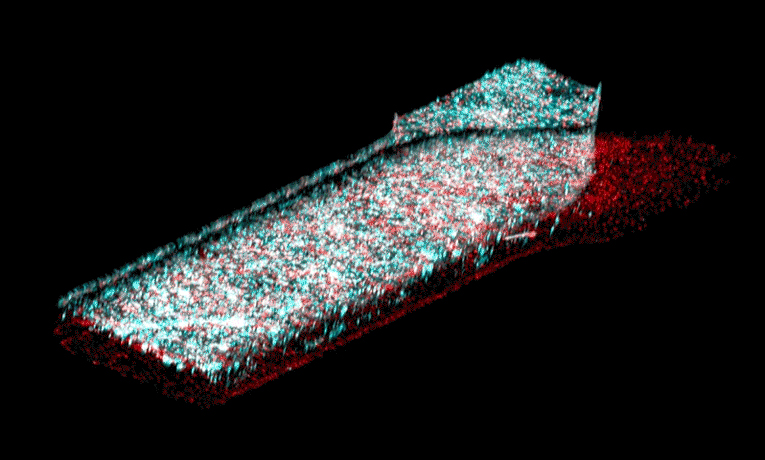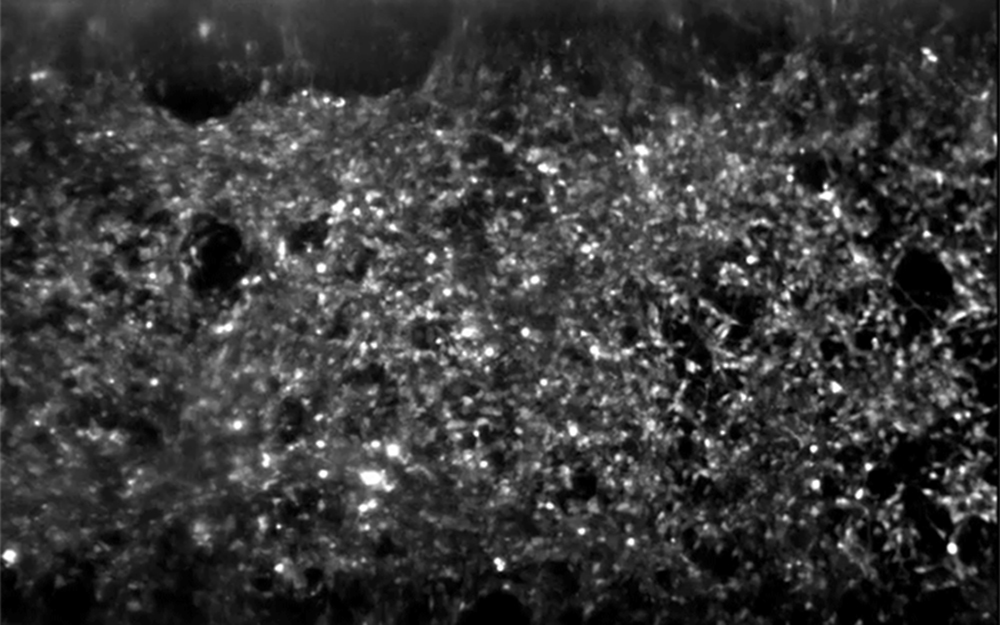Cedars-Sinai Blog
Research Closeup: Treating ALS
May 23, 2018 Cedars-Sinai Staff

Graphic shows layers of spinal motor neuron cells (top, in blue) and capillary cells (bottom, in red) inside an Organ-Chip.
Samuel Sances is a postdoctoral scientist at Cedars-Sinai's Regenerative Medicine Institute. He and his colleagues are using stem cells and Patient-on-a-Chip technology to study how the spine grows in the earliest stages of human development.
The Patient-on-a-Chip program aims to help predict which disease treatments would be most effective based on individual patients' genes.
"We're hoping this could someday lead to insights to help us treat diseases that kill motor neurons, like ALS."
He shared this image from research recently published in the journal Stem Cell Reports.

What are we looking at?
Samuel: We re-created living tissues of blood vessels and cells called spinal motor neurons, which control muscles, so we could see how they interact. The blue parts are the layers of motor neuron cells that form in the spine. The red are cells from capillaries, the tiniest blood vessels. They're interacting together on this chip.
Until now, everyone thought these blood vessels delivered nutrients and oxygen, removed waste, and adjusted blood flow. What we learned was that they're not just plumbing. They're genetically communicating with the neurons. This means they have a more important role than we thought in how the spine develops.

Hundreds of spinal motor neurons spontaneously communicate through electrical signals inside an Organ-Chip. Neurons fire individually (flashing dots) and in synchronized bursts (bright waves). The activity was observed using a dye that fluoresces when neurons send an electrical signal.
Why are you studying these kinds of cells?
Samuel: It helps us better understand how the spine develops, which could be really helpful in finding ways to treat diseases like amyotrophic lateral sclerosis (ALS), also known as Lou Gehrig's disease.
When the human embryo is about 4 weeks old, new blood vessels begin to form around a column of cells that eventually grow into the spinal cord. Developmental genes determine how these cells form, and some of them will turn into the spinal motor neurons. Our study found that the blood vessels are able to activate these genes, which spur the motor neurons to grow and mature.
How could this research help patients in the future?
Samuel: We're hoping this could someday lead to insights to help us treat diseases that kill motor neurons, like ALS. More than 6,000 people in the US are diagnosed with ALS each year, and we don't have a cure.
What may go wrong that causes the muscle-controlling motor neurons to die? If we can make a model of ALS patients' tissues, we may be able to answer that question and find a way to rescue their nerve cells through new therapies.
Now we know these blood vessels play a role in development. Our next step will be to compare how the vessels interact with neurons in ALS patients to how they interact with neurons in people who don't have ALS.
The research is part of the Patient-on-a-Chip program, a collaboration between Cedars-Sinai and Emulate Inc. in Boston. Emulate produces the Organ-Chips used in the program. Geraldine A. Hamilton, PhD, Emulate's president and chief scientific officer, is a co-author of the spinal motor neuron study.
Disclosure: Cedars-Sinai owns a minority stock interest in Emulate Inc. An officer of Cedars-Sinai also serves on Emulate's board of directors. Emulate provides no financial support for this research.
Funding: This research was supported by the National Institutes of Health Tissue Consortium 2.0 under award number 1UG3NS105703- 01, the ALS Association, and the California Institute for Regenerative Medicine.

